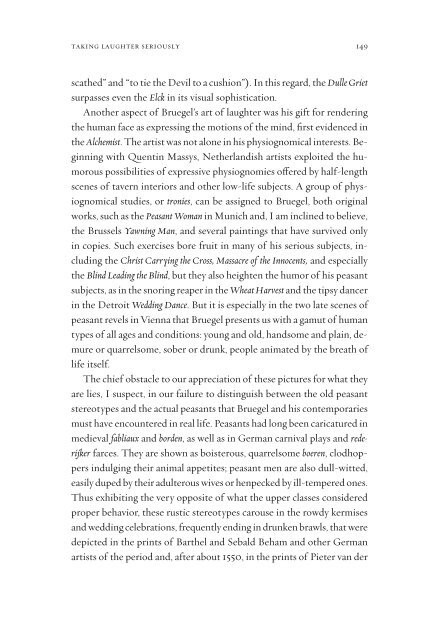Pieter Bruegel and the Art of Laughter - AAAARG.ORG
Pieter Bruegel and the Art of Laughter - AAAARG.ORG
Pieter Bruegel and the Art of Laughter - AAAARG.ORG
Create successful ePaper yourself
Turn your PDF publications into a flip-book with our unique Google optimized e-Paper software.
taking laughter seriously 149<br />
sca<strong>the</strong>d” <strong>and</strong> “to tie <strong>the</strong> Devil to a cushion”). In this regard, <strong>the</strong> Dulle Griet<br />
surpasses even <strong>the</strong> Elck in its visual sophistication.<br />
Ano<strong>the</strong>r aspect <strong>of</strong> <strong>Bruegel</strong>’s art <strong>of</strong> laughter was his gift for rendering<br />
<strong>the</strong> human face as expressing <strong>the</strong> motions <strong>of</strong> <strong>the</strong> mind, first evidenced in<br />
<strong>the</strong> Alchemist. The artist was not alone in his physiognomical interests. Beginning<br />
with Quentin Massys, Ne<strong>the</strong>rl<strong>and</strong>ish artists exploited <strong>the</strong> humorous<br />
possibilities <strong>of</strong> expressive physiognomies oªered by half-length<br />
scenes <strong>of</strong> tavern interiors <strong>and</strong> o<strong>the</strong>r low-life subjects. A group <strong>of</strong> physiognomical<br />
studies, or tronies, can be assigned to <strong>Bruegel</strong>, both original<br />
works, such as <strong>the</strong> Peasant Woman in Munich <strong>and</strong>, I am inclined to believe,<br />
<strong>the</strong> Brussels Yawning Man, <strong>and</strong> several paintings that have survived only<br />
in copies. Such exercises bore fruit in many <strong>of</strong> his serious subjects, including<br />
<strong>the</strong> Christ Carrying <strong>the</strong> Cross, Massacre <strong>of</strong> <strong>the</strong> Innocents, <strong>and</strong> especially<br />
<strong>the</strong> Blind Leading <strong>the</strong> Blind, but <strong>the</strong>y also heighten <strong>the</strong> humor <strong>of</strong> his peasant<br />
subjects, as in <strong>the</strong> snoring reaper in <strong>the</strong> Wheat Harvest <strong>and</strong> <strong>the</strong> tipsy dancer<br />
in <strong>the</strong> Detroit Wedding Dance. But it is especially in <strong>the</strong> two late scenes <strong>of</strong><br />
peasant revels in Vienna that <strong>Bruegel</strong> presents us with a gamut <strong>of</strong> human<br />
types <strong>of</strong> all ages <strong>and</strong> conditions: young <strong>and</strong> old, h<strong>and</strong>some <strong>and</strong> plain, demure<br />
or quarrelsome, sober or drunk, people animated by <strong>the</strong> breath <strong>of</strong><br />
life itself.<br />
The chief obstacle to our appreciation <strong>of</strong> <strong>the</strong>se pictures for what <strong>the</strong>y<br />
are lies, I suspect, in our failure to distinguish between <strong>the</strong> old peasant<br />
stereotypes <strong>and</strong> <strong>the</strong> actual peasants that <strong>Bruegel</strong> <strong>and</strong> his contemporaries<br />
must have encountered in real life. Peasants had long been caricatured in<br />
medieval fabliaux <strong>and</strong> borden, as well as in German carnival plays <strong>and</strong> rederijker<br />
farces. They are shown as boisterous, quarrelsome boeren, clodhoppers<br />
indulging <strong>the</strong>ir animal appetites; peasant men are also dull-witted,<br />
easily duped by <strong>the</strong>ir adulterous wives or henpecked by ill-tempered ones.<br />
Thus exhibiting <strong>the</strong> very opposite <strong>of</strong> what <strong>the</strong> upper classes considered<br />
proper behavior, <strong>the</strong>se rustic stereotypes carouse in <strong>the</strong> rowdy kermises<br />
<strong>and</strong> wedding celebrations, frequently ending in drunken brawls, that were<br />
depicted in <strong>the</strong> prints <strong>of</strong> Bar<strong>the</strong>l <strong>and</strong> Sebald Beham <strong>and</strong> o<strong>the</strong>r German<br />
artists <strong>of</strong> <strong>the</strong> period <strong>and</strong>, after about 1550, in <strong>the</strong> prints <strong>of</strong> <strong>Pieter</strong> van der












